The Australian state of New South Wales is home to six UNESCO World Heritage sites. And there’s a huge variety here, from prehistoric sites to modern architecture, Australian history to tropical paradise. So if you’re looking for information about the UNESCO World Heritage Sites in NSW, read on for our in-depth guide.
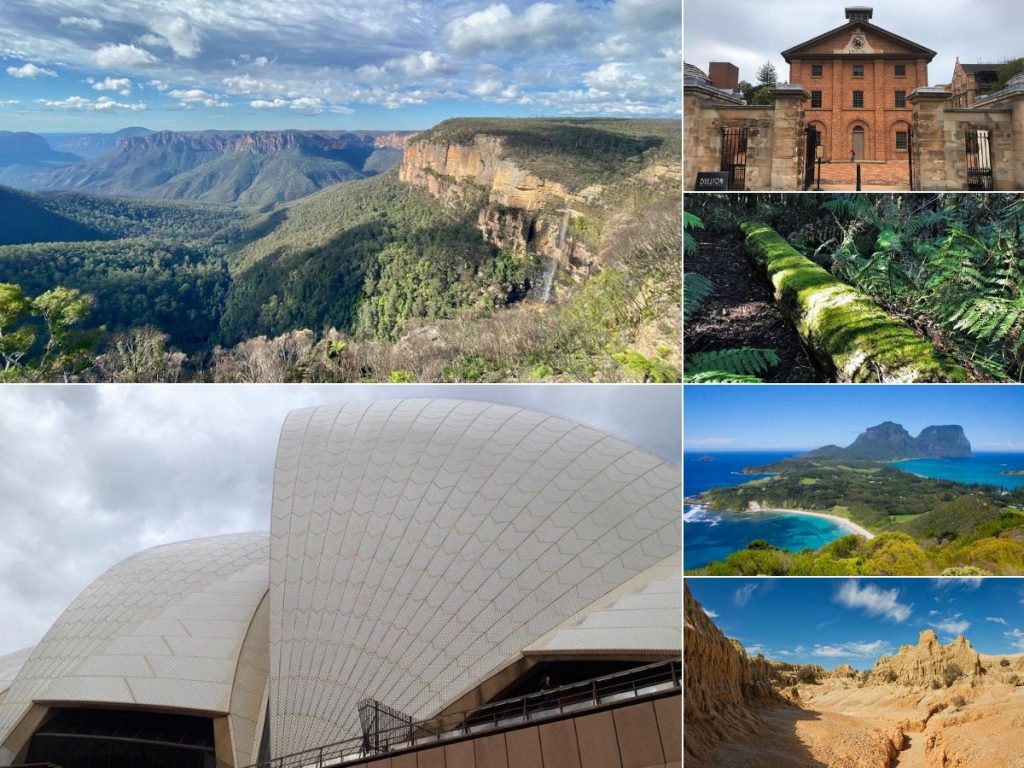
Sydney Opera House – World Heritage Site
The most famous World Heritage Site in New South Wales is definitely the Sydney Opera House. It’s one of our favourite modern architecture World Heritage Sites. The Opera House opened in 1973, and is among the world’s most recognisable buildings. Joern Utzon, a Danish architect, designed the building, but sadly he never saw the finished structure! After a budget dispute with the local government, he quit the project and never returned to Australia. What’s amazing is that prior to its construction, the location was used as a tram depot!
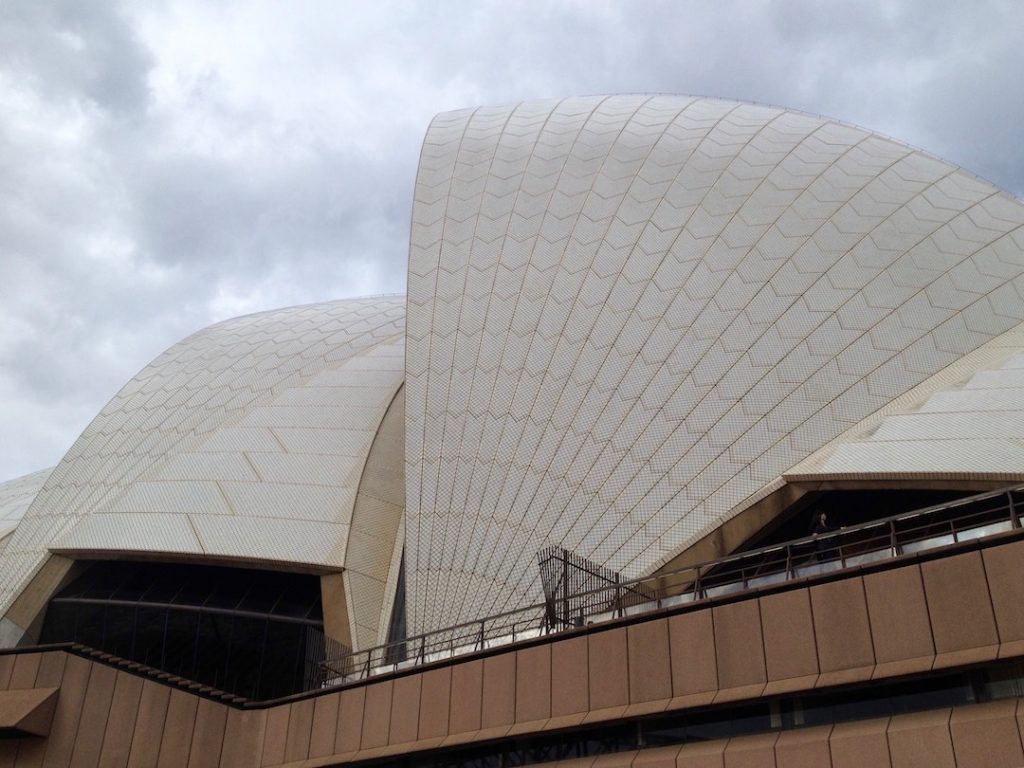
Although it looks like one large building, the Opera House actually consists of three separate buildings on a single podium, and the interior contains seven individual performance spaces. There’s a large concert hall, an opera theatre, playhouse, and smaller rooms as well. There’s over 500 performances in the Opera House every year.
If you don’t manage to catch a performance, you can always take a guided tour of the Opera House. These run daily, and include a few backstage areas.
Australian Convict Sites – World Heritage Site
The city of Sydney was founded as a convict colony in 1788. For the next 75 years, over 160,000 men, women and children were “transported” to Australia as punishment, usually for petty crimes like stealing bread. This World Heritage Site explores what remains from the convict era in various parts of Australia. Four of the Australian Convict Sites World Heritage Site are located in NSW, and all are in the Sydney area.
Hyde Park Barracks
Hyde Park Barracks World Heritage Site is located just a few hundred meters from the Sydney Opera House. It’s an elegant sandstone building, constructed between 1817 and 1819. As the name suggests, it was built as a barracks but not for soldiers – it was a barracks for convicts! At the time, convicts were expected to find their own lodgings, which was a difficult task for many given that they worked six days a week for no pay.
Interestingly, the Barracks building was actually designed by a convict: architect Francis Greenway, who was sent to Australia for forging documents. Governor Macquarie was so impressed by Greenway’s building that he was given a full pardon after the Barracks opened.
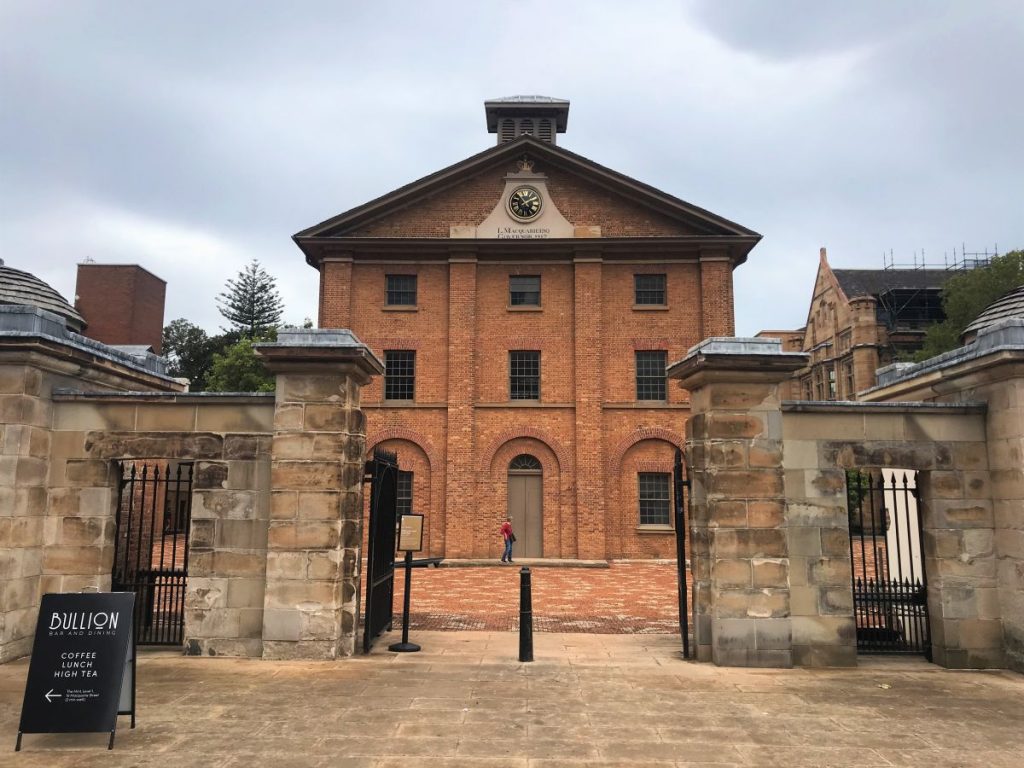
Although originally designed to hold 600 convicts, it wasn’t long before almost 1400 men were crammed in each night, and it’s estimated that around 30,000 convicts passed through the barracks in a 30-year period.
New convicts stopped arriving in Sydney in 1840, and the building was gradually used for other purposes, including a hospital for women, an asylum, an orphanage, and various government departments including law courts. These days, the Barracks is home to an excellent museum about life as a convict in early colonial Sydney.
Cockatoo Island
Another of the Australian World Heritage Convict Sites in NSW is Cockatoo Island, also located in central Sydney. It’s a large island, located in Sydney Harbour, right near the famous Sydney Harbour Bridge.
Cockatoo Island opened as a prison for trouble-making convicts in 1839, and operated for around 30 years. Rich in sandstone, the convicts were employed building barracks, storehouses and shipyards, several of which are still visible on the island today. After the initial construction phase, most of the convicts worked in the shipyards, constructing boats for use in the colony.
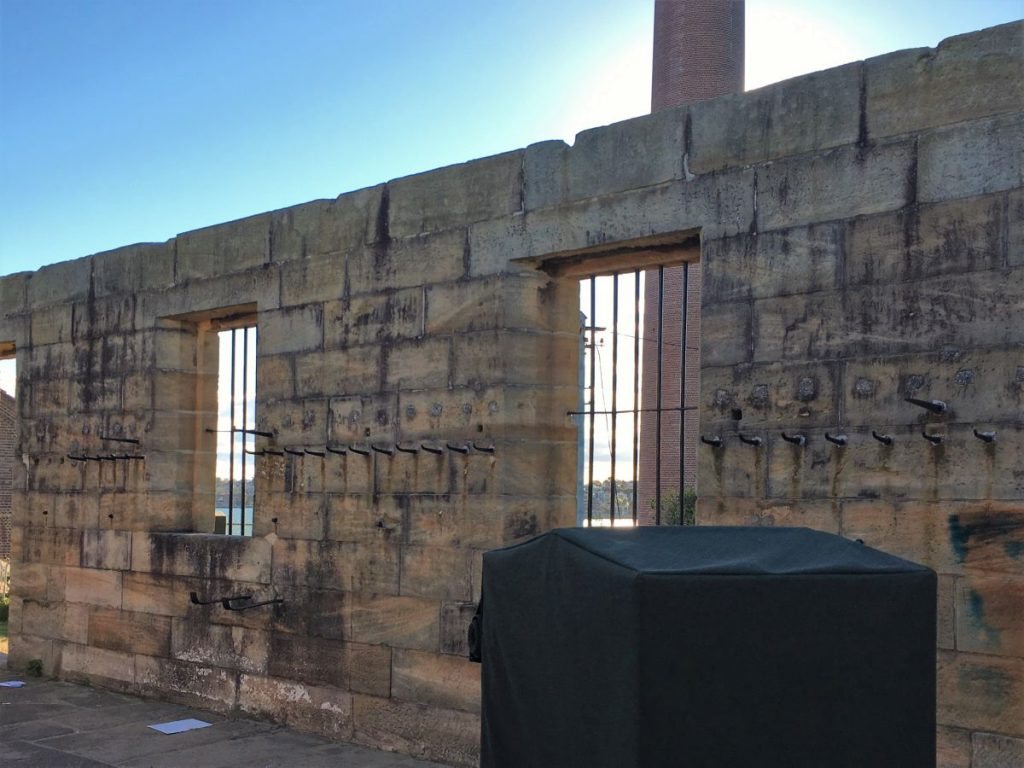
Although the prison ceased operations in 1869, the dockyards on Cockatoo Island kept working – right through until 1991! These days it’s a museum island, where you can learn about Australia’s convict history, and the long tradition of ship-building on the island. There’s also a campground on the island, where you can go glamping and enjoy the magnificent sights of Sydney Harbour at night.
Old Government House
Down the river from central Sydney, about 25 kilometres west, stands Old Government House in the suburb of Parramatta. This large brick building was constructed in around 1799 and completed in 1820, largely using convict labour, and remains today as one of Australia’s oldest public buildings.
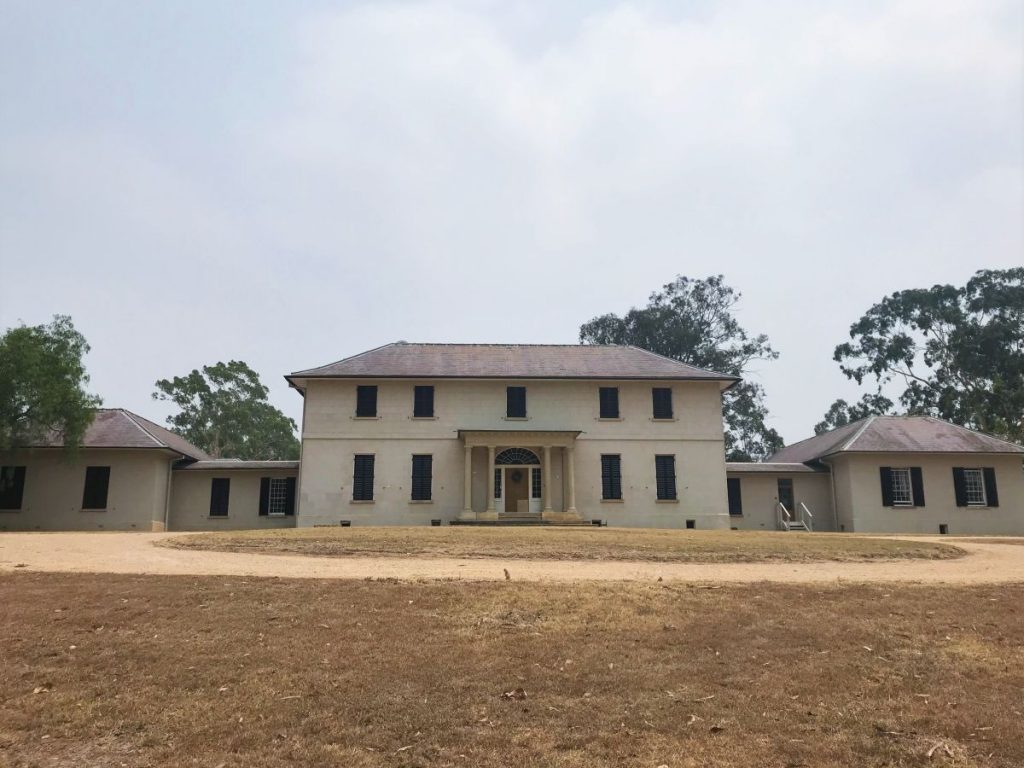
It was built as the primary residence for John Hunter, Governor of the colony of New South Wales, as it was then known. Although subsequent governors over the next 50 years made additions and modifications, the House still largely exists now as it did in the early 19th century. One fascinating detail is the walls – although they look like elegant stone blocks, they’re actually bricks covered with a mortar and a stonework pattern scratched into the surface!
Inside the house there’s lots of original furnishings too, including one of the oldest pieces of furniture in Australia. Exploring the interior is fascinating, as it really gives you a sense of what this building was like back in the day, as the epicentre of power in the convict colony. For decades, half of the Australian continent was ruled from this very room!
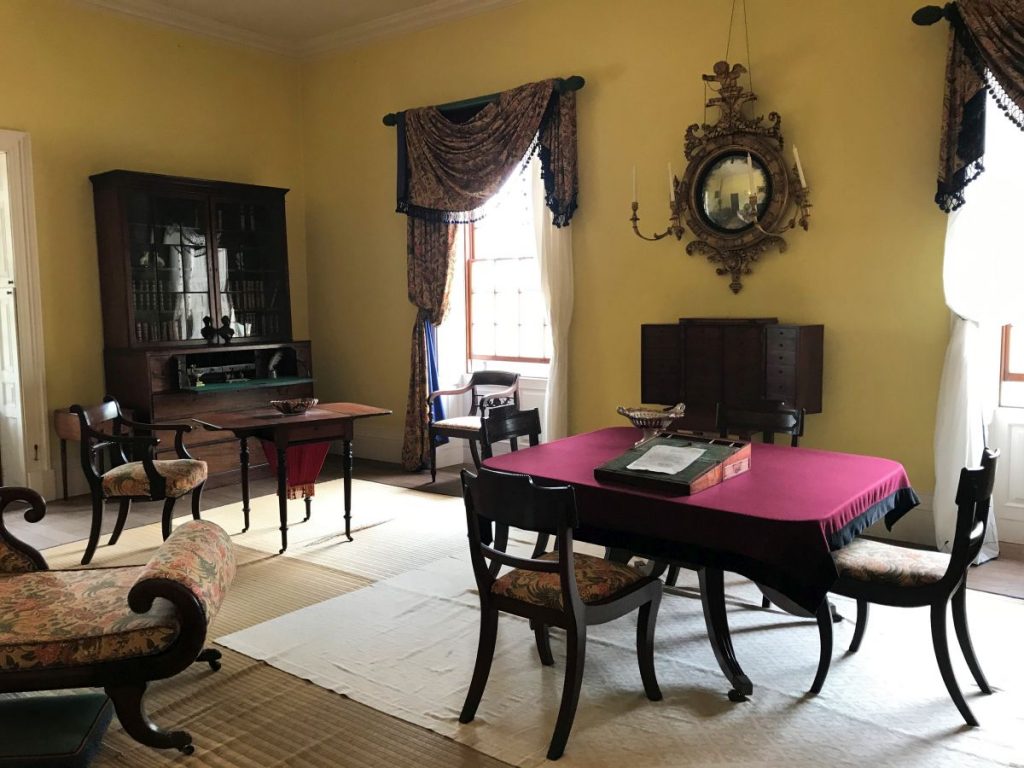
Old Great North Road
Last of the Australian Convict Sites in NSW is the Old Great North Road, located north-west of Sydney. Built between 1825 and 1834, it was a major feat of engineering for the young colony. Starting near Parramatta River, the Road headed north through extremely rough and rugged country. After 200 kilometres, it finally connected with the important mining and agriculture districts of the Hunter Valley.
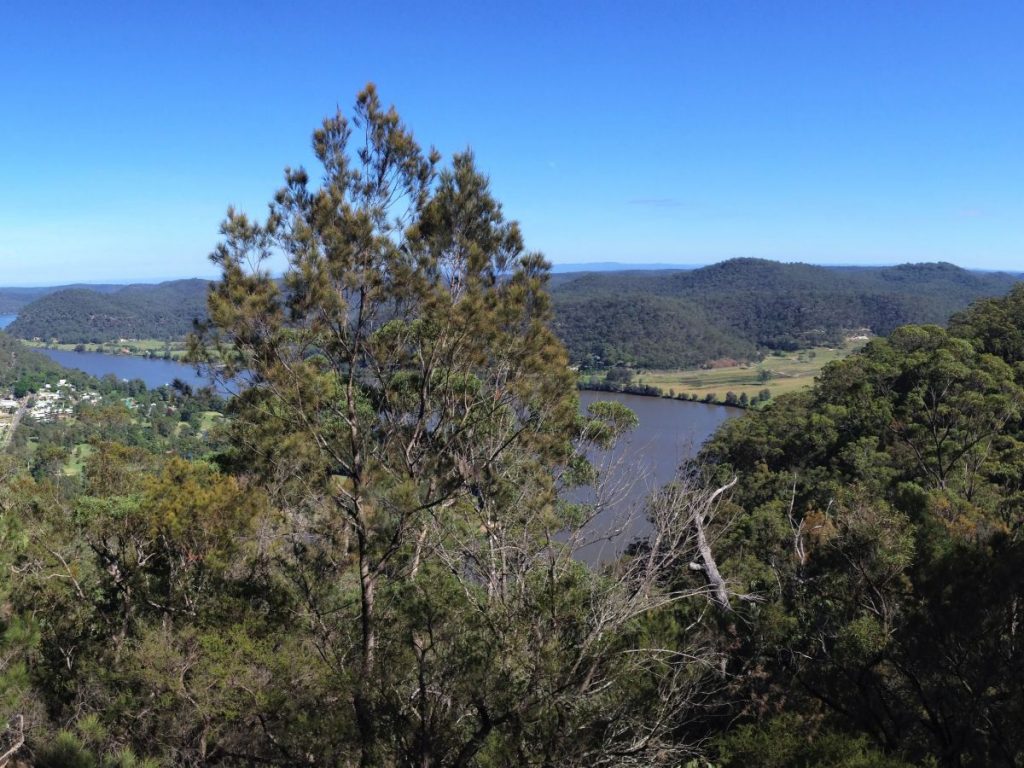
Sadly, the Road never quite reached its potential. The remote areas it traversed were rough and inhospitable, with very little fresh water available and no access to feed for animals. In addition, steamships were becoming increasingly common, so moving goods and people by sea became a cheaper and easier option.
The Great North Road still exists in various areas today, though it’s mostly buried underneath modern roads. One of the last remaining convict-built sections is near Wisemans Ferry on the Hawkesbury River, and there’s a fantastic bushwalk along the old convict road.
Greater Blue Mountains Area – World Heritage Site
The colossal Greater Blue Mountains Area UNESCO World Heritage Site consists of 8 separate national parks in a large area to the west of Sydney. They’re actually part of a much larger chain of mountains known as the Great Dividing Range, which runs along the entire eastern coast of Australia. Although the majority of the World Heritage area is remote and inaccessible, the most famous area is at Blue Mountains National Park, centred around the town of Katoomba.
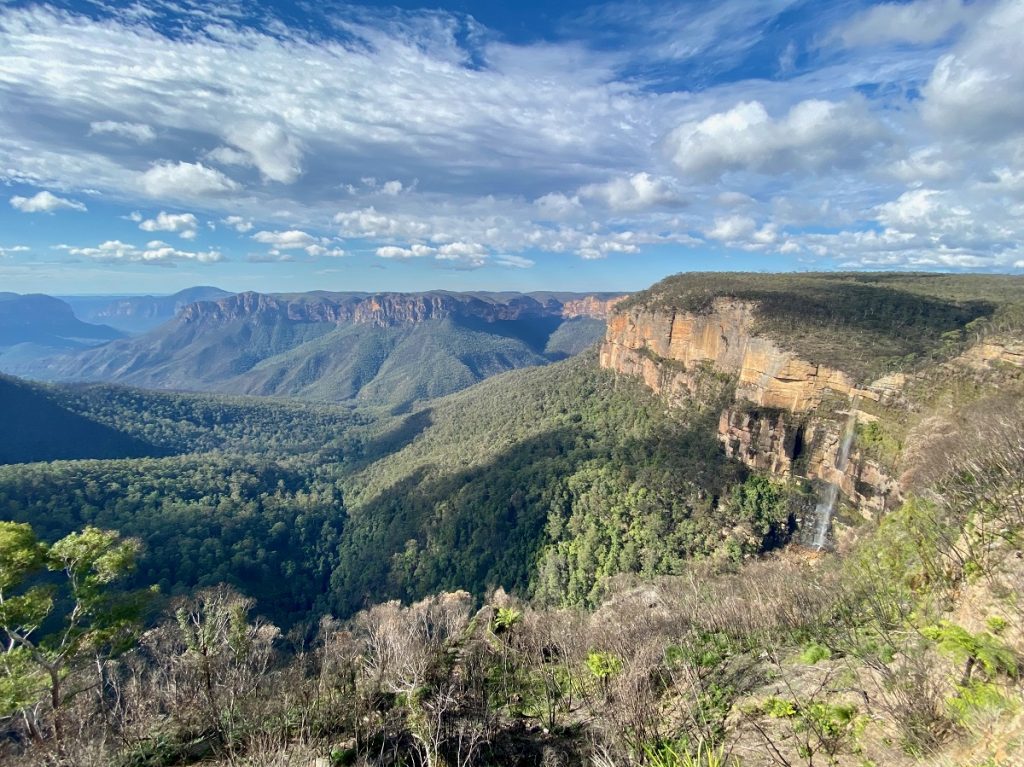
Despite being called “mountains”, the area is really a sandstone plateau, about 1100 metres elevation with long deep gorges and valleys, carved out by rivers and creeks. And it makes for a spectacular sight: the glowing golden sandstone ringed with trees, the rugged terrain below every lookout, and waterfalls cascading over cliffs.
One of the best-known features is the Three Sisters, a sandstone outcrop right near Katoomba. Erosion has created three distinct peaks in the sandstone, resembling three figures standing next to each other.
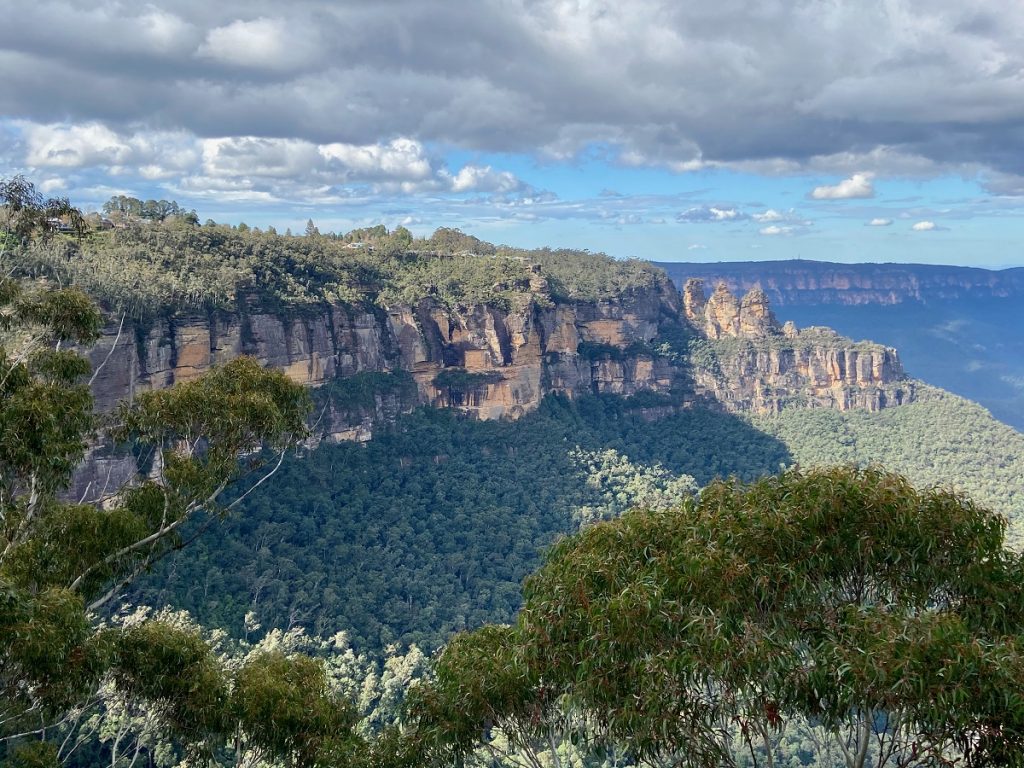
Not far away is the incredible Wentworth Falls, where a small creek cascades several hundred metres over the escarpment. You can even stand out in the stream and watch the water from behind as it disappears into the valley, which is quite an unusual sight!
The Blue Mountains World Heritage Site is also home to the Wollemi Pine, one of Australia’s rarest trees. Originally, it was known only from 200 million year old fossils, and it was thought to be extinct until a small grove of trees was discovered in a remote area of the World Heritage site. Ironically, although the Wollemi Pine is still critically endangered in the wild, it can actually be found in gardens and suburban backyards across Australia thanks to a successful cloning program.
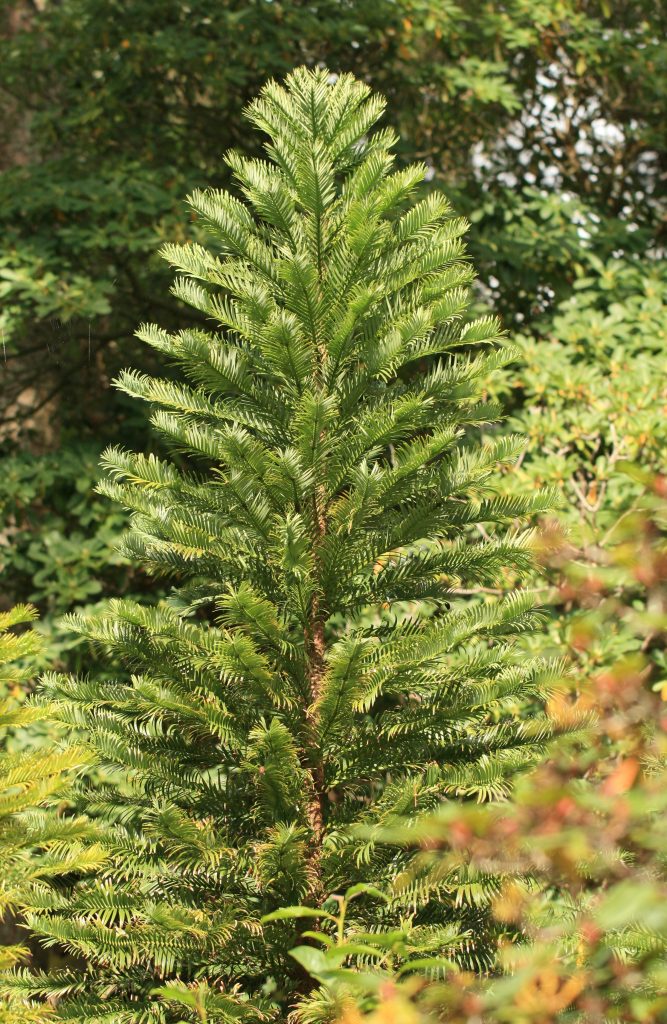
The Blue Mountains area is very popular with hikers and people doing day trips from Sydney, and we’ve been hiking in various parts of the Mountains many times over the years. There’s an incredible variety of easy, medium and hard walking tracks, with spectacular views on offer. And if you’re lucky, you might even catch a glimpse of Australia’s famous animals!
Gondwana Rainforests of Australia – World Heritage Site
The next UNESCO Site in NSW is dotted along a large stretch of mountains in the north of the state. When Australia was part of the super-continent Gondwana, it was entirely covered in rainforests. These days, Australia is the hottest and the driest continent on Earth, and very little of the Gondwana rainforest remains. This World Heritage Site highlights the small patches of Gondwana rainforests that still exist, both in New South Wales and just across the border in Queensland.
The Gondwana Rainforests World Heritage Site consists of fifty separate national parks and nature reserves, totalling an impressive 350,000 hectares. There’s a huge amount to cover here, but some of the highlights include:
Oxley-Wild Rivers National Park
Our first stop was at Oxley-Wild Rivers National Park, in the Hastings-Macleay area. Although it’s largely a eucalyptus forest, there are small isolated patches of rainforest that can be seen from various lookouts and explored from several walking tracks. But the absolute highlight here is definitely Wollomombi Falls, which at over 200 metres is among the highest in Australia. The falls are at the end of a large gorge that’s just covered in rainforest, and it’s a fantastic sight from the nearby lookouts. Unfortunately there wasn’t much water going over the falls when we visited, but in full flow it’s apparently an incredible sight!
New England National Park
Next up was New England National Park, located to the east in the New England group, and it was here that we started to realise why the Gondwana Rainforest was so special. Starting at the Point Lookout, 1500m above sea level, you’re surrounded by high-altitude temperate rainforest, and looking down on a sea of sub-tropical and warm temperate rainforest below you.
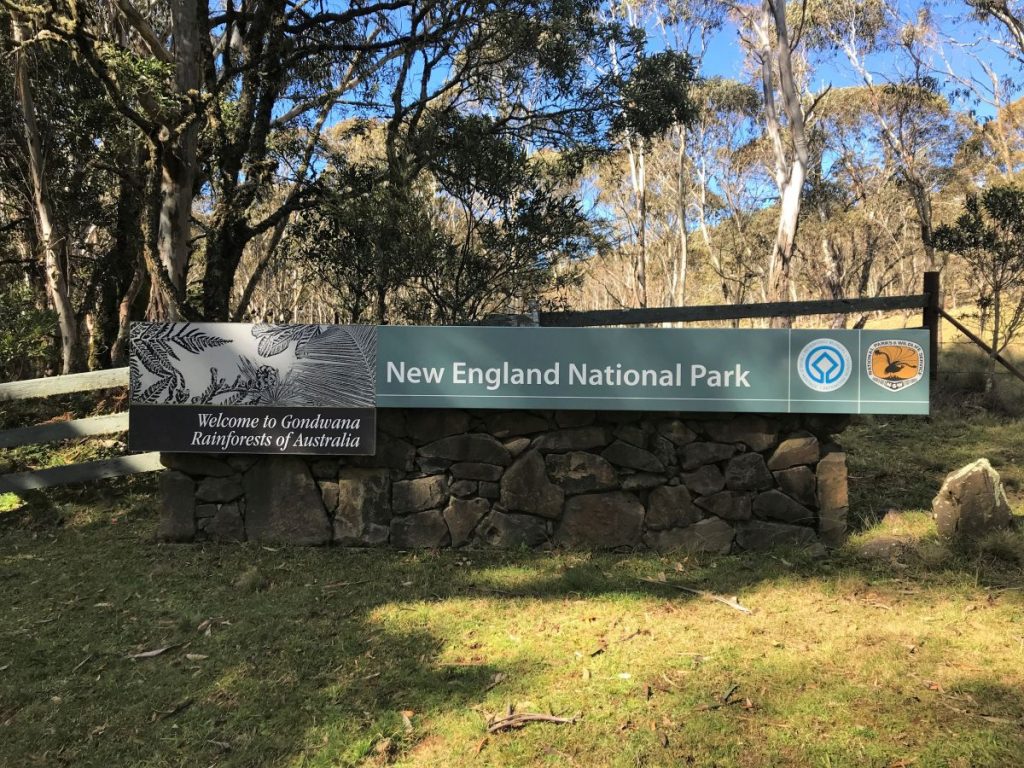
Hiking through the forest here is a real treat, as you’re up close and personal with all sorts of rainforest trees and plants, mosses and lichens. It’s fascinating to see how the dense rainforest canopy keeps the ground cool and dark, even at high altitudes. The views from Point Lookout are also sensational, looking down off the escarpment across wooded valleys to the Pacific Ocean, 70 kilometres distant.
Dorrigo National Park
Our next visit was to Dorrigo National Park, still in the New England group. Located at a lower altitude from the New England park, Dorrigo is home to the fascinating Skywalk. Here, you can walk on an elevated catwalk through the upper canopy of the rainforest, giving you a fantastic close-up view of the birds, trees and animals that make their homes in the rainforest canopy.
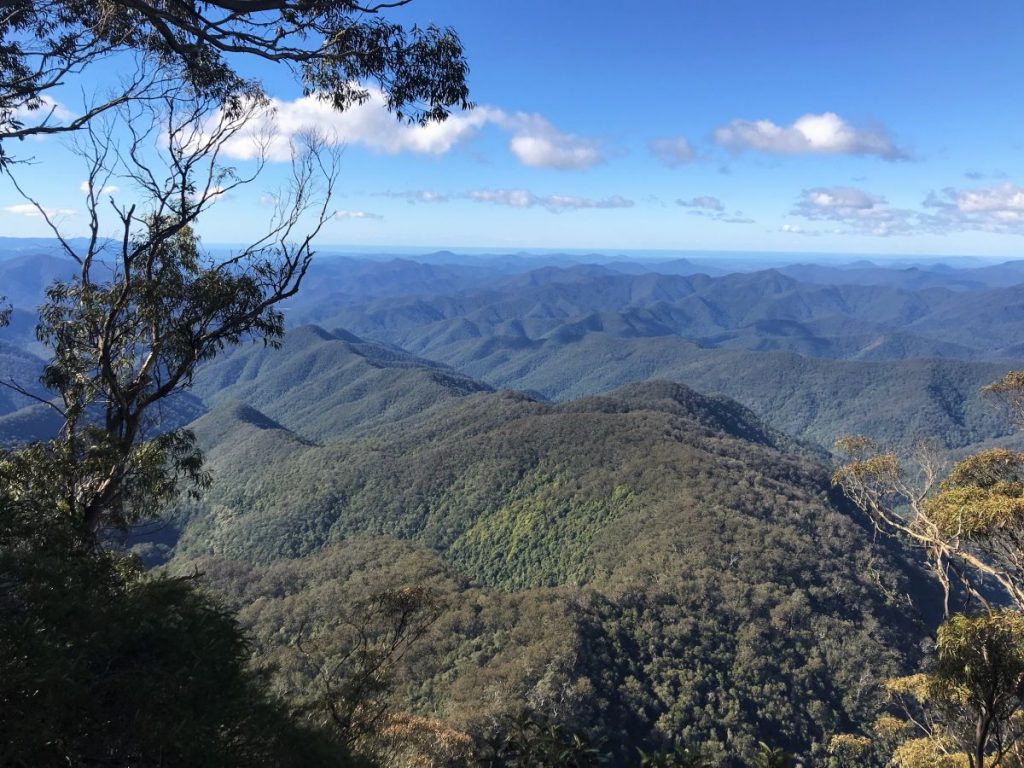
From here you can also take a stairway that plunges down the side of a cliff to the forest floor, fully immersing yourself in the environment. Surrounded by dark and damp, it’s fascinating to see how the varying levels of sunlight affect different areas of the forest. Down here you’ll find loads of beautiful forest floor plants, like ferns, mould, lichen, moss and mushrooms, plus some ground dwelling birds like the brush turkey and the superb lyrebird.
And then there’s the final section: another catwalk through the mid-level of the canopy, with trees towering above you and the floor falling away. It’s an incredible experience, and really shows just how special the Gondwana Rainforests are.
Nightcap National Park
Heading further north, we also visited Nightcap National Park, part of the Shield Volcano group and located just outside the famous surfing town of Byron Bay. Nightcap is another large area of sub-tropical rainforest, and we immediately headed for its most famous attraction: Minyon Falls.
Here at Minyon you’ll find a 100m high plunge waterfall, off the edge of an extinct volcano. Although the top of the falls is located in eucalyptus forest, it plunges directly into the rainforest which makes for a fantastic view: ferns, palms, figs and other rainforest trees reaching up towards you.
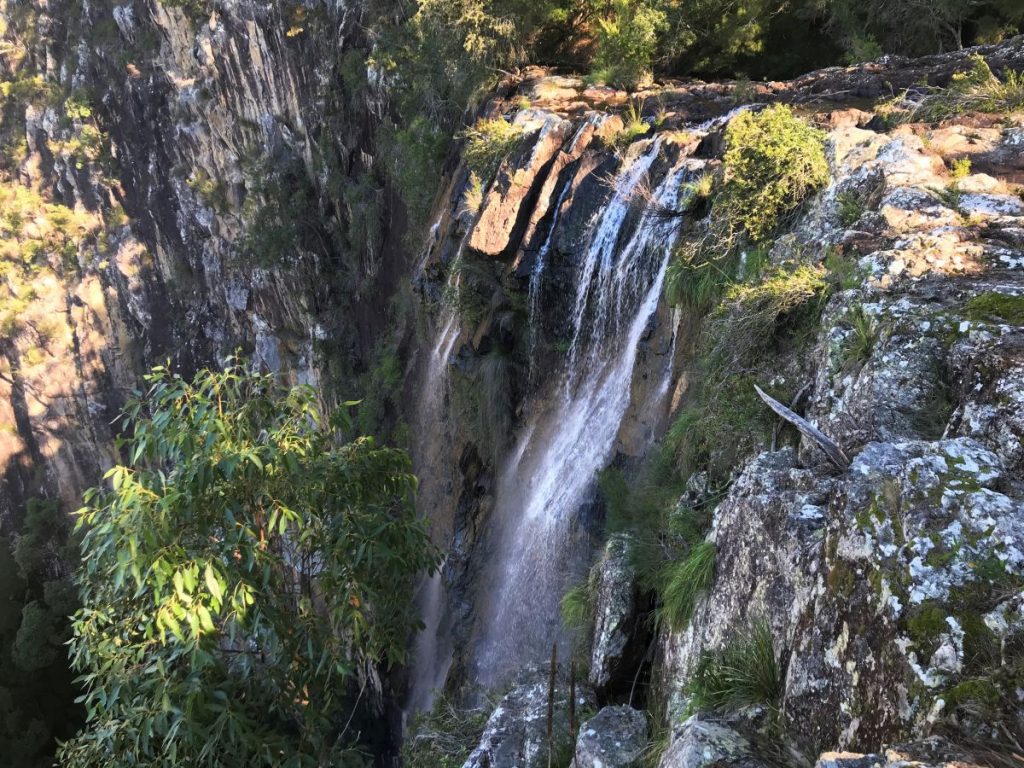
Iluka Nature Reserve
The final part of this World Heritage Site that we visited was the Iluka Nature Reserve, located dramatically on the coast. It’s one of the last examples in New South Wales of littoral, or beachfront rainforest. This area is quite a fascinating ecosystem, because although you walk through a typical dark and cool rainforest, surrounded by animal noises and undergrowth with a towering canopy overhead, you can actually hear the surf pounding just a few hundred metres away.
And the environment itself is really interesting, because the salt air and sea breezes from the ocean restrict the upper reaches of the canopy. Salt-crusted leaves and branches fall down into the sandy undergrowth, where they become a haven for small creatures like birds, snails, mushrooms and moss. These in turn provide food for the larger trees, growing up to the canopy tops, at which point the cycle begins again.
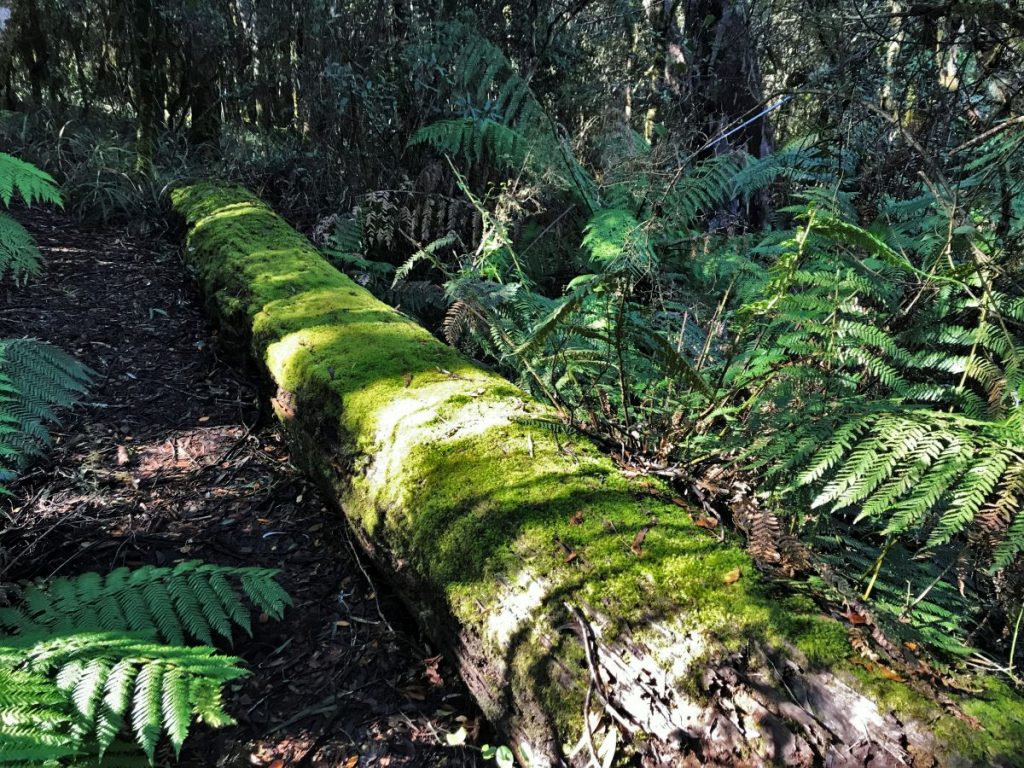
One of the most interesting plants at Iluka is the Strangler Fig. This epiphyte (parasite plant) starts life as a seedling injected into the trunk of a healthy tree. Over time it grows tendrils up and down the existing tree, strangling it, and eventually replacing it entirely. There’s quite a few examples here, and they’re always interesting to look at – although they are a bit horrifying when you think about it. Sort of like the face-huggers in Aliens!
Lord Howe Island – World Heritage Site
The Lord Howe Island UNESCO World Heritage Site is one of Australia’s genuine hidden treasures. We’ve written about Lord Howe Island on World Heritage Journey in the past, and it’s honestly a magical place. Located about 800 kilometres north-east of Sydney, off the Australian mainland, Lore Howe is an extinct volcano surrounded by coral reefs and covered in tropical rainforest.
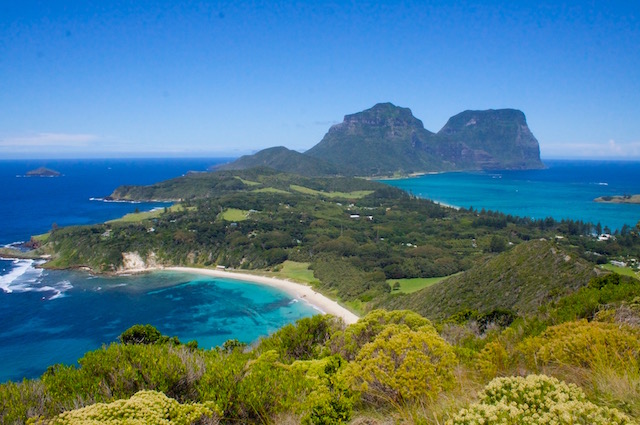
Exploring is a lot of fun, as tourist numbers on the island are capped at a very low level, so it’s never that crowded. There’s always space on the pristine beaches, no competition for the best surfing and snorkelling spots, and the views from Mount Gower back across the island are spectacular.
It’s also home to several species of migratory birds, including several endangered species. A huge part of the island is reserved for bird sanctuaries, and bird-watching is another of the great pleasures on Lord Howe.
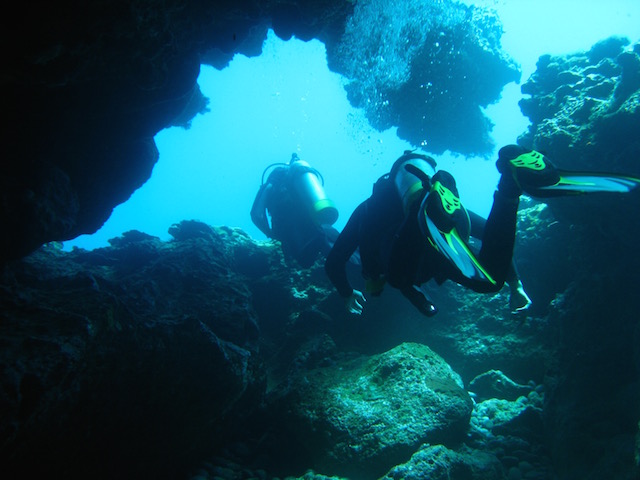
Willandra Lakes – World Heritage Site
Last of the six UNESCO Sites in New South Wales is the Willandra Lakes area, located in the far south-west of the state. Covering a large 240,000 hectares, the name Willandra Lakes is slightly misleading. The Lakes in question are dry lakes, without water for tens of thousands of years.
Because of the very stable geology and the surrounding arid zones, the Willandra Lakes area has fantastically preserved records of early life and human development. There’s plenty of evidence here, demonstrating that humans lived in the Willandra Lakes area at least 40,000 years ago – an almost unimagineable span of time.
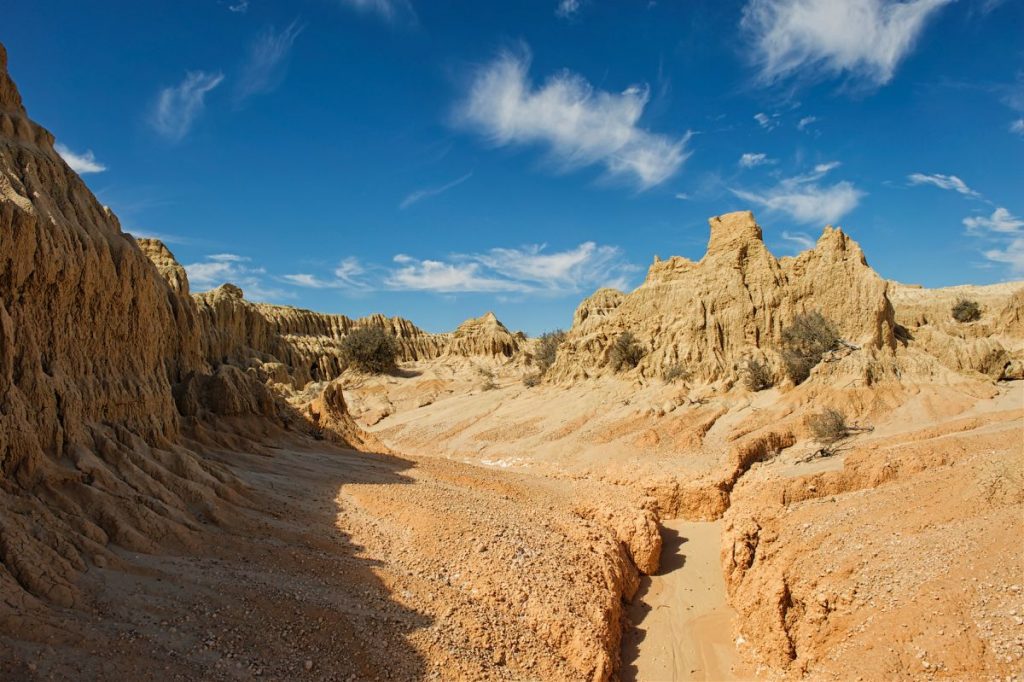
Lake Mungo is the best known of the 17 lakes that make up the Willandra Lakes area. This is where the Mungo Man and Mungo Woman remains were found – ritually cremated human bodies, dating to around 45,000 years ago. They’re the oldest known ritual cremations in the entire world, which is really something. Their presence suggests a sophisticated prehistoric culture existed in the area, likely living around the shores of the Lake (which at the time still had water in it).
Archaeologists have also found evidence of stone tools, hearths, and shell middens, along with fossils of giant marsupials that have long gone extinct. It’s a fascinating place to visit, and one that we look forward to getting back to in the near future.
